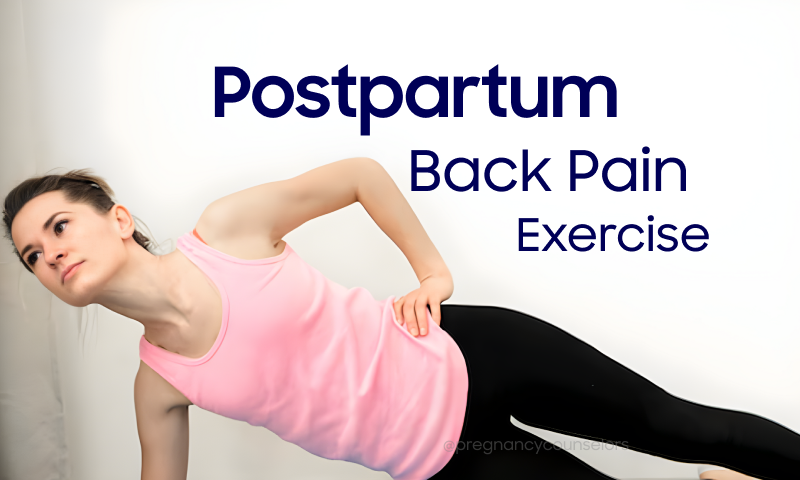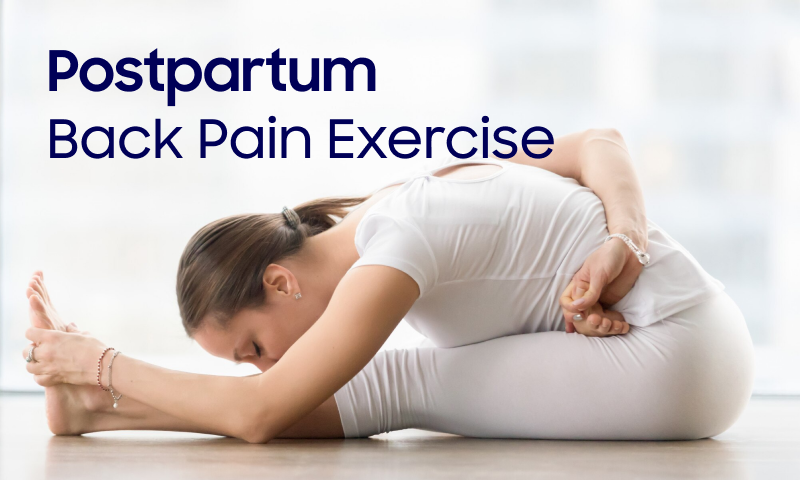Introduction
For every woman, bringing a new life into the world is certainly a miraculous and fulfilling event. However, the postpartum phase has a unique set of difficulties, with postpartum back pain becoming a common problem among moms. Pregnancy and childbirth can cause physical stress on the spine, which can cause discomfort and limited mobility for new moms. In this post, we’ll examine the causes of postpartum back pain and discuss postpartum back pain exercises to address this problem.
Understanding Postpartum Back Pain
Among new mothers, postpartum back pain is a common problem that frequently results from a combination of pregnancy and delivery-related conditions. Pregnancy causes the uterus to develop, which changes the body’s center of gravity and spine to experience more pain. In addition, the ligaments and muscles are affected by the hormonal changes that take place during pregnancy. And that may lead to lower back stiffness and instability.
The back is under a great deal of stress during childbirth. Particularly if hard work is extended or specific delivery techniques are used. Muscle strains or weakness are frequently the outcome of it, especially in the lower back and pelvis.
Importance of Postpartum Back Pain Exercises
Specifically designed exercise is a key component of the postpartum rehabilitation process, especially for back pain. Exercise improves flexibility overall, helps with posture, and strengthens the core muscles. It also helps to restore muscular tone, speeds up recovery, and increases blood circulation. Postpartum workouts must, however, be done carefully, with a focus on moderate activities that progressively increase strength and endurance.
Postpartum back pain physical therapy is a common and effective approach to address and reduce postpartum back pain. Back pain postpartum treatment typically involves exercises to strengthen core muscles, improve posture, and increase flexibility. Physical therapists may also use manual therapy techniques to target specific areas of pain or tension. The treatment plan is often personalized based on factors such as the type of delivery, overall health, and individual needs.

Exercises to reduce Postpartum Back Pain
There are some Postpartum Exercises for Back Pain which will help you a lot and they are:
Pelvic Tilts
Technique:
Lie on your back comfortably, with your feet flat on ground and your knees bent.
Taking a deep breath, raise your pelvis and press your lower back into the floor.
Take a deep breath out, arch your lower back slightly, and tilt your pelvis downward.
Do this exercise ten to fifteen times over.
Benefits:
Strengthens the muscles of the pelvic floor.
Increases the flexibility of the lower back.
Cat-Cow Stretch
Technique:
Position yourself in table position with your hands and knees.
Breathe in while bending your back and lowering your abdomen to the ground (Cow pose).
When you curve your back and drop your chin into your chest, release the breath (cat position).
Do ten to twelve repetitions of this movement.
Benefits:
Increases spinal flexibility.
Strengthens and activates the core muscles.
Bridge Exercise
Technique:
Keep your feet hip-width apart, your knees in bent position, and then lie on your back.
Breathe in and raise your hips so that your shoulders and knees are in a straight line.
After a brief period of holding, release the air and bring your hips back down.
Do this 12–15 times.
Benefits:
Builds stronger lower back and glute muscles.
Helps to stabilize the pelvic area.
Seated Spinal Twist
Technique:
Take seat on floor then stretch your legs outwards.
With the foot flat on the ground, cross one leg over the other.
With the opposite elbow on the outside of the knee, twist your torso in the direction of the bent knee.
After 20 to 30 seconds of holding, switch sides.
Benefits:
Reduces lower back and spine strain.
Increases the motion of the spine.
Pelvic Floor Exercises (Kegels)
Technique:
Contract muscles of your pelvic floor and Make it as if you are stopping the flow of pee.
After 5 to 10 seconds of holding the contraction, release it.
Do this exercise 10-15 times over.
Benefits:
Strengthens the muscles of the pelvic floor, hence supporting the lower back.
Helps with control of the bladder.
Gentle Cardiovascular Exercises
Technique:
Start with swimming and walking as they are low-impact exercises.
Increase the intensity gradually as your strength and endurance increase.
Benefits:
Promotes better cardiovascular health.
Encourages weight loss, which eases back pain.
Postpartum yoga
Technique:
Take part in postpartum yoga sessions designed keeping new mothers’ needs in mind.
Concentrate on postures that encourage relaxation and strengthen the core.
Benefits:
Blends mindfulness with light stretching.
Supports health of body & mind.
We told you some of the best postpartum back pain exercises, you can do which you find comfortable & easy.
Precautions and Tips for Postpartum Back Pain Exercises
Despite the potential benefits of postpartum back pain exercises, it’s important to practice caution:
- Consult with your healthcare provider:
Be sure any postpartum fitness program you begin is safe and appropriate for your unique situation before beginning it.
- Start slowly:
As your strength increases, progressively increase the intensity of your workouts from low to high. Pay attention to your body and don’t overdo exercises.
- Focus on proper form:
When performing exercise, pay close attention to your technique to avoid placing excessive stress on your back or other muscles.
- Stay hydrated:
Sufficient fluid intake is important for both muscular growth and recovery after childbirth.
- Include rest in your routine:
Make time for rest a part of your schedule so that your body can heal. Back pain can become worse by lack of sleep and excess exercise.
Conclusion
Many new mothers experience postpartum back discomfort. But you can successfully reduce it with postpartum back pain exercises and a focused approach to healing. Prioritizing soft movements that progressively increase flexibility, strengthen the core, and enhance general well-being is crucial. You may start your journey to a healthier, pain-free back and an improved sense of postpartum recovery, by including these exercises into your routine and adopting the appropriate safety measures.
Also Read – Managing Tarlov Cysts Exercises
Frequently asked questions
Q1: How long does postpartum back pain last?
Ans: It lasts about 6 months.
Q2: What helps back pain after delivery?
Ans: Low-impact exercises like yoga, walking, or stretching exercises.
